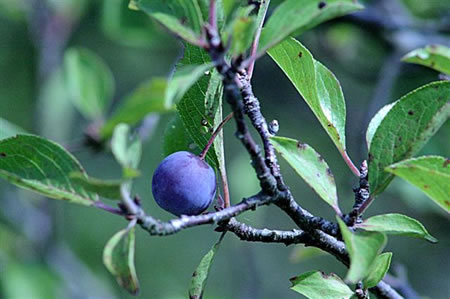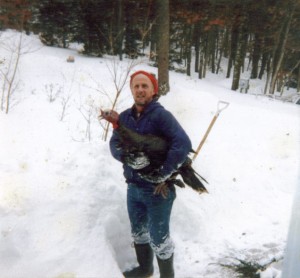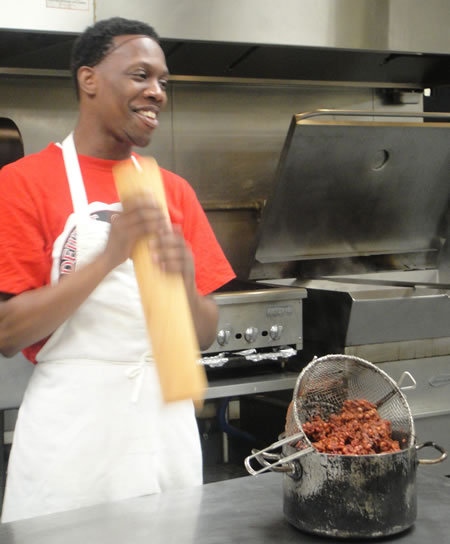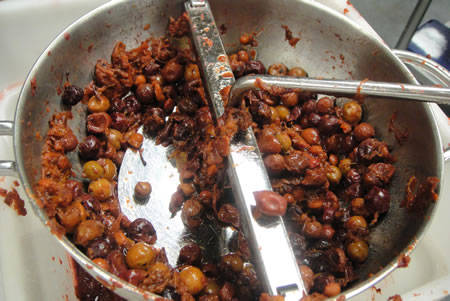Stalking the Wild Beach Plum
Here is a our story about the elusive Wild Beach Plum.

Prunus Maritima is a member of the rose family and often confused with rose hips by the uninitiated. Beach plums grow along the seashores of the Atlantic coast from Eastern Canada to Virginia.
They range in size from a small Nicoise olive to a giant Sicilian olive. But they have a huge pit – and often more suited to jelly making than that of a true preserve. They are a finicky plant, producing an overwhelming abundance one year and almost nothing the next.

Ron G - The Forager
Another problem is where to find them. No true forager reveals their sources. In fact, when asked where the beach plums are found, almost unanimously the answer is “if I tell you I will have to kill you.” Our forager is a third generation farmer and carpenter from East Hampton who gleefully brought a hundred or more pounds of beach plums to me 3 years ago. Ron G keeps a little book with “his” foraging haunts and has brought us wild beach plums, wild grapes, wild cherries and wild cranberries. He fights the ticks and the poison ivy and I really think he loves this work.
There was such a bounty that first year. We had no idea what to do with all the beach plums. Ron made jelly from his mother’s recipe and I began experimenting with preserves. We made beach plum liquor and liquor soaked beach plums. I even pickled some. The following year, after Huricane Irene, the bushes were barren. This year, the harvest was a pretty good one if you got to them before the other foragers. You also have to beat the deer who are known to eat beach plums.
The taste is a cross between a plum and a prune with a heady tang and an especially deep flavor.
As I began selling this preserve at the markets, my customers shared family stories of parents dragging bands of children onto the beaches with pails to pick the beach plums – they only produce fruit along the bay and the ocean. Farmers and bankers alike, all making jam and jelly over the years.
The preserve making is time consuming. First you wash,sort and pit. Then I mix the berries with cane sugar and let them macerate over night in a true method confituer – this helps to develop the natural pectin. Cooking is also tempermental. The fruit gels only when the proper balance of water to sugar to fruit pectin is reached. Then we hand jar, vacuum seal in a water bath, cool and label our preserves.

Eli in the Kitchen processing the Beach Plums after Food Milling
In an effort to better understand the beach plum I registered for a class at the New York Horticultural Society in the Fall. It was given by Gary Lincoff who has foraged with Euell Gibbons himself over the years. His talk was wonderful and his book is even better – The Joy of Foraging. I highly recommend it, especially if you want to add a little purslane to your salad, but that is a conversation for another day. Gary finds beach plums along the coast of New York City and Long Island. He pits the plums with an antique cherry pitter – because, “it still works as good as anything.” He served his Beach Plum Preserves over a ricotta cheese cake. Couldn’t be better.

Gary Lincoff at the New York Horticultural Society - 2012

[…] Feast! Wins 2013 Good Food Award for Hand Foraged Wild Beach Plum Preserve [PR Web] Stalking the Wild Beach Plum [Josephine's […]
[…] wrote a wonderful story, “Stalking the Wild Beach Plum,” on the Josephine’s Feast blog (including a photo of Ron, the forager) about how she began making this particular kind of […]
They do fruit inland. There’s a large and productive grove of them at Lockwood Farm in Hamden, Connecticut. Like beach plums on the beach, some years they take vacation from fruiting. But some years they are very productive.